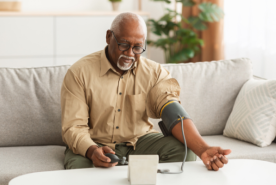The general term pruritus means very itchy skin caused by a long-term disease, such as chronic kidney disease (CKD). It is also know as CKD-Associate Pruritus
About Pruritus
Pruritus is very itchy skin that is most common in patients with advanced CKD and end-stage kidney disease (ESKD), but which can also happen in the early stages of CKD. Pruritus is also known as uremic pruritus because the build-up of toxins and wastes in damaged kidneys, known as uremia, has been associated with itching. Recent scientific evidence suggests that uremia is not the exclusive cause of itching in CKD. As a result, the more appropriate name for this condition is Pruritus.
Pruritus can bother patients a lot and get in the way of daily life. Scratching to stop the itch can harm the skin, so finding the right treatments is very important. Pruritus affects each person in a different way, so you need to work with your doctor and healthcare team to find what works best for you. Because Pruritus is often ignored by both patients and their healthcare team, patients may not get the relief they need. This can lead to loss of sleep, shorter or missed dialysis sessions, fatigue, depression, and infections, among other problems.
Cause of pruritus
The cause is not fully known, but many changes in the body related to CKD may cause itching. Studies on pruritus have revealed a few theories about its cause, along with other factors that make the condition worse.
In an immune response to CKD, the body may attack itself and become inflamed and itchy. Certain lab values found in people with CKD, such as low white blood cell count, may mean that the body is inflamed. Itching due to this immune response is known as the immune theory of pruritus.
Studies have also shown that signals sent to opioid receptors in nerve cells may be off balance in CKD, which then leads to itching. In CKD, the mu receptors become too active, while the kappa receptors are blocked, which is not normal. This imbalance is known as the opioid theory of pruritus.
These are other factors related to CKD and ESKD that may be related to pruritus:
- Not enough dialysis for proper removal of toxins and wastes
- High parathyroid hormone (PTH) levels in the blood
- A combination of high calcium and phosphorus levels in the blood
- High magnesium or aluminum levels in the blood
- Cells in the body release histamine and other chemicals that cause itching
- Shrinking sweat glands cause very dry skin, also called xerosis
- Nerve damage due to CKD and ESKD
Diagnosing pruritus
Pruritus varies in the way each patient experiences it, ranging from on occasion and hardly a problem, to constant and very disturbing. It may happen at any time -- before, during, or after dialysis, night and/or day. In up to half of patients, pruritus affects the whole body, and in that case, it usually affects both sides of the body. But it can also only affect one part of the body, usually the face, back, and the arm with a vascular access. pruritus is known to be made worse by extreme hot or cold temperatures, stress, physical activity, and showering.
Pruritus can happen without any signs on the skin, or it can happen along with xerosis, and/or it can include itching, skin sores, and skin infections. Because pruritus is a common condition in the advanced CKD and dialysis populations, any itching in these groups could be from pruritus, unless there’s another clear reason, such as liver disease or a drug reaction.
The diagnosis of pruritus requires a team effort that centers on the patient’s report of their symptoms. Healthcare professionals may choose to do a skin exam, assess common dialysis lab values, and try topical treatments in order to pinpoint the diagnosis.
Treatment of pruritus
Patients on dialysis should be treated for high PTH, phosphorus, and magnesium levels in the blood. This may include certain medicines, increasing dialysis treatment times, and/or changing the type of dialysis filter or dialysis prescription. All patients should start with topical treatments that are rubbed on top of the skin, including emollients, which are creams and lotions that soothe and moisten the skin, and/or analgesics, which are creams and lotions that relieve pain and itching.
If those steps don’t work, then allergy pills called antihistamines may help. Some of these drugs can make you sleepy (sedated), so other types such as loraditine that don’t make you sleepy might be used during the day and the ones that make you sleepy can be used at night.
For patients who are still itchy despite topicals and oral histamines, drugs used for nerve pain, including gabapentin or pregabalin, can be tried since the neural pathways for both pain and itch are related. If these drugs don’t work, there are other treatment options, such as ultraviolet B (UVB) phototherapy for patients who are not kidney transplant candidates. UVB therapy is associated with an increased risk of cancer and should not be used in patients who are on immunosuppressant drugs. UVB therapy should not be used in patients with systemic lupus erythematosus, because of photosensitivity.
For hemodialysis patients, a new drug called difelikefalin has been approved by the United States Food and Drug Administration (FDA) for CKD-aP. It’s the only FDA approved drug specific for the diagnosis of CKD-aP. It’s given through a vein during dialysis. This drug works by improving the imbalance of nerve signals that leads to itching in patients with CKD and ESKD.
Other experimental treatments used for CKD-aP include omega-6 and omega-3 fatty acids, as well as drugs that bind toxins in the gut such as charcoal and cholestyramine, among others that you should discuss with your healthcare team as needed.
What can you do about pruritus?
Talk with your doctor and healthcare team. Tell them about your itching and ask about treatments. You may need to see a skin doctor (dermatologist) or other doctors to find the exact cause of your itching and the best treatments. There is help for pruritus and you should speak up about it. With pruritus, the diagnosis starts with YOU, the patient. This will then lead to treatment that can bring you relief and a better quality of life.

















